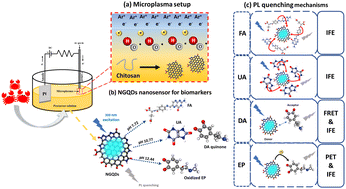Bioresource-derived colloidal nitrogen-doped graphene quantum dots as ultrasensitive and stable nanosensors for detection of cancer and neurotransmitter biomarkers†
Abstract
Rapid and accurate detection of cancer and neurological diseases is a major issue that has received great attention recently to enable early therapy treatment. In this report, we utilize an atmospheric pressure microplasma system to convert a natural bioresource chitosan into nitrogen-doped graphene quantum dots (NGQDs) for photoluminescence (PL) based selective detection of cancer and neurotransmitter biomarkers. By adjusting the pH conditions during the detection, multiple biomolecules including uric acid (UA), folic acid (FA), epinephrine (EP), and dopamine (DA) can be simultaneously detected with high selectivity and sensitivity using a single material only. Linear relationships between the biomarker concentration and the PL intensity ratio are obtained starting from 0.8 to 100 μM with low limits of detection (LoDs) of 123.1, 157.9, 80.5, and 91.3 nM for UA, EP, FA, and DA, respectively. Our work provides an insight into the multiple biomarker detection using a single material only, which is beneficial for the early detection and diagnosis of cancer and neurological diseases, as well as the development of new drugs.

- This article is part of the themed collection: 2023 Journal of Materials Chemistry B Lunar New Year


 Please wait while we load your content...
Please wait while we load your content...